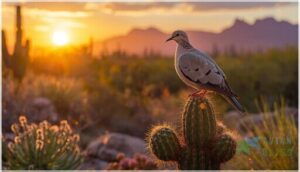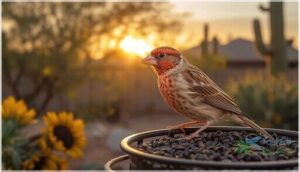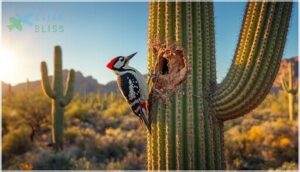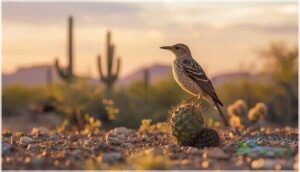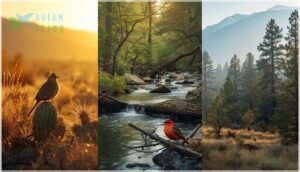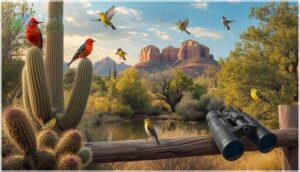This site is supported by our readers. We may earn a commission, at no cost to you, if you purchase through links.
Arizona’s skies host nearly 550 bird species—more diversity than most states can claim. The secret lies in the state’s dramatic elevation shifts, from scorching Sonoran lowlands to cool alpine forests above 12,000 feet. Each zone creates distinct ecosystems where desert specialists like Cactus Wrens extract moisture from insects while mountain-dwelling warblers forage in Douglas fir canopies.
You’ll find Mourning Doves in nearly half the state and Gila Woodpeckers hammering saguaro cacti in Phoenix suburbs.
Whether you’re scanning riparian corridors that shelter 60-70% of regional species or exploring state parks with 300+ documented birds, Arizona rewards observers who understand where elevation, water, and habitat converge.
Table Of Contents
- Key Takeaways
- Common Bird Species in Arizona
- Arizona Bird Habitats and Where to Find Them
- Best State Parks for Birdwatching in Arizona
- Bird Migration Patterns and Seasonal Changes
- Conservation and Economic Impact of Arizona Birds
- Frequently Asked Questions (FAQs)
- What kind of birds do you see in Arizona?
- How do I identify a bird in my backyard?
- What is the most common bird in Phoenix Arizona?
- What is the speckled bird in Arizona?
- What kind of birds does Arizona have?
- What rare birds can you see in Arizona?
- What are the noisy birds in Phoenix?
- What is the tiny GREY bird in Tucson?
- What birds can you see in Arizonas national parks?
- What are the best binoculars for birdwatching?
- Conclusion
Key Takeaways
- Arizona hosts nearly 550 bird species across dramatic elevation shifts from desert lowlands to 12,000-foot alpine forests, with riparian corridors sheltering 60-70% of regional species despite occupying minimal land area.
- Desert-adapted birds like Cactus Wrens and Gila Woodpeckers have mastered extreme survival strategies—extracting water from food rather than free sources and nesting in protective cacti—but face 2-7% annual population declines from habitat loss and climate pressures.
- Spring migration from mid-April to mid-May transforms Arizona into a birding hotspot with up to 230 species passing through riparian corridors and desert oases, while winter counts routinely exceed 150 species in prime southeastern locations.
- Birdwatching tourism generates $1.4 billion annually for Arizona’s economy and supports 3,000 jobs, with conservation programs now protecting 3.38 million acres through the Important Bird Areas Program as climate change threatens 43% of breeding birds.
Common Bird Species in Arizona
Arizona’s bird scene is a mixed bag of desert survivors and suburban regulars. You’ll spot some of these species year-round, whether you’re hiking canyon trails or scanning your backyard feeder.
Here are the eight most common birds you’re likely to encounter across the state.
Mourning Dove
You’ll spot mourning doves year-round in Arizona, with a statewide frequency of 47.01%. These desert birds favor open habitats like urban areas and prairies. Dove nesting habits stretch from March through October, with peak activity from April to July.
Mourning dove migration begins in early September, bringing new arrivals mid-month. Bird population trends show Arizona maintains some of the highest breeding densities in the Western region. The mourning dove population is affected by strychnine poisoning cases.
House Finch
You’ll find House Finches nearly as often as mourning doves, at 45.94% occurrence statewide. These permanent Arizona residents show impressive urban adaptation, thriving in backyards and city parks. Watch for their distinctive finch behavior during breeding season from March through August.
Their nesting habits and seed preferences reveal impressive survival strategies:
- Diet dominance: Over 90% plant-based, favoring sunflower seeds and thistle
- Flock dynamics: Large foraging groups form outside breeding periods
- Breeding output: Three to six eggs per clutch, with both parents feeding nestlings
The House Finches’ ability to adapt is evident in their breeding season habits.
Gila Woodpecker
The Gila Woodpecker stands out as a true desert architect among Arizona bird species. At 34.02% occurrence, this woodpecker species demonstrates exceptional urban adaptation while maintaining its ecosystem engineering role.
You’ll witness their cavity excavation skills as they carve nest holes in saguaros—nesting habits that benefit multiple species. Their omnivorous woodpecker diet includes insects and cactus fruits, making them essential to birdwatching in Arizona.
Lesser Goldfinch
Lesser Goldfinches rank fourth in Arizona bird species occurrence at 31.47%, thriving in diverse habitats from backyards to mountain forests. These year-round residents adjust migration patterns, moving to lower elevations in winter.
You’ll spot their acrobatic flocking behavior as they hang upside-down extracting seeds from thistles and sunflowers—their primary seed preferences.
Breeding seasons run April through July, with nesting habits focused on dense shrubs where they raise multiple broods.
Verdin
Ranking fifth at 30.39% occurrence, Verdins build their signature twig nests throughout Arizona’s desert lowlands below the Mogollon Rim. You’ll recognize their acrobatic feeding patterns as they hang beneath leaves extracting aphids and caterpillars while visiting hummingbird feeders for nectar.
Despite adapting to urban environments, Verdin populations face conservation challenges from habitat loss, showing -7.8% annual declines in Texas monitoring regions since 1966.
Cactus Wren
Arizona’s state bird, the cactus wren, thrives in thorny desert habitats, building football-sized nests in cholla cacti and mesquite. You’ll spot these bold songbirds defending territories year-round across elevations up to 4,600 feet.
Despite their adaptable cactus wren behavior and arid adaptations supporting desert ecology, populations face 2.1% annual declines since 1970. Habitat loss from urbanization threatens these permanent residents, making wren conservation critical for Arizona birdwatching enthusiasts and maintaining diverse bird species throughout Sonoran landscapes.
Anna’s Hummingbird
You’ll find Anna’s hummingbird year-round across Arizona’s urban gardens and desert scrub, making it the state’s most common hummingbird species for birdwatching enthusiasts.
Unlike migratory hummingbirds, this adaptable resident breeds remarkably early—December through June—raising multiple broods when hummingbird feeders and winter-blooming flowers provide steady nectar.
Their feeding habits include hovering at native blooms and catching insects midair, thriving in nesting sites from suburban shrubs to 7,000-foot elevations.
Curve-billed Thrasher
You’ll recognize the Curve-billed Thrasher by its distinctive down-curved bill, perfectly adapted for flipping stones and digging through desert soil for insects and spiders.
This permanent resident thrives in Arizona’s Sonoran Desert habitats, nesting sites within cholla cacti from 500 to 6,100 feet elevation.
Breeding habits include laying 3–5 eggs, with both parents sharing incubation duties while maintaining their bold, year-round desert adaptation.
Arizona Bird Habitats and Where to Find Them
Arizona’s landscape shapes where you’ll find its birds. Each habitat—from sunbaked deserts to cool mountain forests—hosts species perfectly adapted to those conditions.
Let’s look at the main habitat types and the birds that call them home.
Desert-Adapted Birds
The Sonoran Desert pushes avian heat tolerance to its limits, yet birds of the Sonoran desert have mastered survival here. You’ll spot species like the cactus wren securing most of its water from food, not free-standing sources. Desert nesting inside prickly cacti shields them from predators, while restricted dawn-and-dusk activity minimizes exposure.
Desert bird decline signals trouble for aridland ecosystems. Watch for:
- Cactus Wrens using cactus for protection and nest sites
- Curve-billed Thrashers hunting invertebrates in shrubby desert bird habitats
- Verdins thriving in sparse vegetation zones
- Gila Woodpeckers carving homes in living saguaros
- Common Poorwills catching night insects with specialized flight
Desert bird conservation efforts target these bird species in Arizona facing habitat loss and climate stress.
Riparian and Wetland Birds
You’ll encounter Arizona’s richest bird diversity where water flows. Riparian areas support 60–70% of bird species in the region, despite occupying minimal land.
These corridors host 307 breeding species and serve as critical migration stopovers. Wetland birds like the endangered Southwestern Willow Flycatcher depend entirely on these aquatic habitats.
For waterfowl management and wetland conservation, riparian ecology remains essential to preserving Arizona bird species.
Mountain and Forest Birds
You’ll spot a different world above 6,000 feet. Arizona’s mountain habitats support over 500 native bird species, with 137 documented in the Pinaleño Mountains alone.
High-elevation forests host specialized residents like Yellow-eyed Juncos and Red-faced Warblers—ground-nesters thriving in dense sapling stands near drainage bottoms.
These biodiversity hotspots face climate pressures, making conservation efforts and avian research critical to protecting Arizona’s montane ornithology treasures.
Urban and Suburban Birds
You’ll find thriving bird communities where cities meet desert. Urban areas like Phoenix and Tucson support 31% to 86% of regional bird species, with peaks during winter months.
Mourning Doves and House Finches dominate suburban habitats, while Gila Woodpeckers excavate saguaros in residential neighborhoods. Green spaces matter—parks boost species richness notably.
Urban birding and backyard birdwatching reveal how bird identification changes with urban planning and bird feeding practices.
Best State Parks for Birdwatching in Arizona
Arizona’s state parks offer some of the best birdwatching opportunities you’ll find anywhere in the Southwest. Each park protects unique habitats that attract different species throughout the year.
Here are five top destinations where you can spot everything from desert dwellers to riparian specialists.
Red Rock State Park
Red Rock State Park ranks among Arizona’s top birding destinations, with 2010 surveys documenting 4,137 individual birds across 58 species. Bird counts regularly exceed 80 species seasonally throughout Arizona state parks for birding.
You’ll find remarkable species diversity along Oak Creek’s riparian corridor, where conservation efforts protect breeding populations of Common Black-Hawks and Yellow-billed Cuckoos. Park trails provide access to distinct habitats, from dense cottonwood galleries to upland zones.
Patagonia Lake State Park
Patagonia Lake State Park shelters roughly 300 bird species across 3,497 acres of riparian and marsh habitats. You’ll spot rare breeding Western Yellow-billed Cuckoos, Gray Hawks, and winter flocks of up to 15,000 Sandhill Cranes when water levels cooperate.
Conservation efforts protect this designated Important Bird Area, where park trails and viewing platforms let you track migration patterns along one of Arizona’s most productive wildlife viewing corridors.
Dead Horse Ranch State Park
You’ll find nearly 200 bird species at Dead Horse Ranch State Park, where riparian woodlands along the Verde River create critical habitat for migrants and residents.
The annual Verde Valley Birding and Nature Festival draws hundreds to observe Bald Eagles, Common Mergansers, and waterfowl flocks exceeding 1,000 birds.
Park bird counts routinely top 30 species per outing, supporting essential avian research and wildlife conservation in Arizona.
Kartchner Caverns State Park
You’ll discover over 150 bird species at Kartchner Caverns State Park, where desert, grassland, and riparian habitats meet beneath the Whetstone Mountains. Park trails wind through diverse Arizona ecosystems hosting Acorn Woodpeckers and Broad-billed Hummingbirds.
Hummingbird migration peaks March through June, drawing avian research teams. Bird surveys reveal specialty species like Montezuma’s Quail.
Cave ecosystems support habitat conservation efforts, while citizen science strengthens desert ecosystems monitoring statewide.
Lyman Lake State Park
You’ll encounter nearly 180 bird species at Lyman Lake State Park, where a 1,500-acre reservoir meets pinyon-juniper forest at 6,000 feet elevation. The lake ecosystem sustains diverse Arizona bird habitats and migration patterns through habitat restoration initiatives.
Park management tracks these species through bird surveys:
- Waterfowl rafting events with hundreds of ducks and geese during migration
- Specialty birds including Mexican Duck and Summer Tanager
- Raptors like Bald Eagle wintering in adjacent forest
Wildlife conservation programs monitor this critical stopover site for habitat conservation research.
Bird Migration Patterns and Seasonal Changes
Arizona’s skies tell a different story each season as migration waves reshape the birding landscape throughout the year. Some species arrive to breed during the warmer months, while others push through on their way to distant destinations or settle in for the winter.
Here’s what you can expect to see as the seasons shift.
Spring Migration Patterns
Spring migration transforms Arizona into a birding hotspot from March to mid-June. Peak activity occurs from mid-April to mid-May, when up to 230 species arrive along major migration routes.
You’ll witness millions of songbirds pass through riparian corridors and desert oases—critical stopover habitats where travelers refuel. Bird tracking reveals migrants travel at 2,100 feet, with flight patterns concentrated in forested areas and wetlands.
Species arrival brings warblers, hummingbirds, and flycatchers north.
Summer Breeding Birds
Summer breeding birds transform Arizona’s habitats from May through mid-August. Over 130 species nest in Sonoran Desert landscapes, with the Black-throated Sparrow and Verdin leading the count.
Monsoon effects trigger grasshopper surges, fueling breeding success for Loggerhead Shrikes and Chihuahuan Meadowlarks. Bird surveys track 307 breeding bird species statewide.
Climate vulnerability threatens 102 species if temperatures rise 3°C, making habitat protection critical for summer breeding birds.
Fall Migration Highlights
You’ll witness Arizona’s fall migration spectacle from August through November, when approximately 440 million birds fly south through the state. Radar tracking captured peak traffic of 42,700 birds on September 5-6, 2025, in Yavapai County.
Bird counts at Grand Canyon exceeded 5,000 raptors in fall 2024, including record Broad-winged and Swainson’s Hawks. Weather impacts increasingly delay migration patterns.
Winter Birding Opportunities
After fall’s rush, winter birding opportunities in Arizona deliver outstanding rewards. You’ll find over 150 bird species during major winter bird counts, with southeastern sites routinely exceeding 120 documented species per survey.
- White-crowned Sparrows arrive in September and stay through March
- Prime locations include Sweetwater Wetlands and Gilbert Water Ranch
- Overwintering raptors include Golden Eagles and Ferruginous Hawks
- Winter tourism contributes $1 billion annually to conservation efforts
Conservation and Economic Impact of Arizona Birds
Arizona’s birds face real challenges, from shifting climates to shrinking habitats, but they also drive serious economic value through tourism. Understanding these pressures helps you see why conservation matters and how your birdwatching trips support local communities.
Here’s what’s shaping the upcoming state of Arizona’s avian populations and the dollars they bring in.
Climate Change Impacts on Arizona Birds
Climate change is quietly rewriting the story of Arizona’s avian ecology. Temperatures have climbed about 2 degrees Fahrenheit over the last century, triggering ecosystem disruption across desert habitats.
This temperature rise drives habitat loss through drought and wildfire. Nearly 43% of breeding birds have vanished from Mojave Desert sites, pushing species toward bird extinction without urgent bird conservation efforts focused on habitat preservation.
Rising temperatures and drought have erased nearly half of breeding birds from Mojave Desert sites, threatening extinction without immediate conservation action
Habitat Loss and Urbanization Effects
Beyond climate shifts, urban sprawl slices through Arizona’s bird habitats at an alarming pace. Phoenix’s expansion—one of America’s fastest-growing metros—has triggered habitat fragmentation that hits desert birds hard.
Here’s what urban planning and development have cost Arizona’s native avifauna:
- Nearly 50% of aridland bird habitats lost since 1968
- Bendire’s thrasher populations down 90% due to sprawl
- Bird occupancy dropped 9% in Phoenix neighborhoods recently
- Pinyon Jay declined 83.5% over five decades
Ecosystem degradation from urbanization creates “extinction debt”—where bird displacement continues even after construction slows. Wildlife conservation strategies now focus on habitat preservation through smart urban areas management, protecting riparian corridors where seven threatened species struggle. Conservation ecology efforts target restoring fragmented landscapes before more iconic desert birds vanish.
Invasive Species Management
Invasive species add another layer to Arizona’s conservation puzzle. House sparrows—one of the state’s most damaging invaders—steal nest sites from native birds like cactus wrens, while feral pigeons spread disease through urban flocks.
Management strategies combine habitat restoration with targeted removal programs. From 2016 to 2020, wildlife services addressed damage from 113 bird species, focusing efforts where invasive bird control protects vulnerable aridland populations.
Economic Benefits of Birdwatching Tourism
Birdwatching pumps serious cash into Arizona’s economy—$1.4 billion statewide from wildlife tourism, with southeastern regions alone seeing $330 million annually.
You’ll find eco tourism supporting 3,000 jobs in places like Pima County, where local spending on lodging and meals adds up fast.
Tax benefits circle back too, generating $1.8 billion for communities that invest in conservation and birding infrastructure.
Conservation Programs and Recovery Efforts
You’ll see conservation initiatives targeting Arizona’s struggling bird populations through coordinated habitat restoration and species monitoring. The Arizona Important Bird Areas Program protects 3.38 million acres, while wildlife conservation projects in Pima County have doubled native plant species and boosted bird diversity from 35 to 63 species.
Conservation planning now focuses on ecosystem management for tipping-point species, combining invasive removal with biodiversity and conservation efforts across riparian zones.
Frequently Asked Questions (FAQs)
What kind of birds do you see in Arizona?
Arizona boasts an absolutely staggering 569 documented bird species—from the iconic Cactus Wren to migratory warblers.
You’ll spot desert-adapted residents like Gila Woodpeckers, riparian specialists, and high-elevation forest dwellers across diverse habitats statewide.
How do I identify a bird in my backyard?
Start by comparing your backyard birds’ size, beak shapes, and feather patterns to field guides. Listen for distinctive bird calls. Watch nesting habits and behavior.
Mobile apps like Merlin Bird ID simplify identification for beginners practicing backyard birdwatching.
What is the most common bird in Phoenix Arizona?
If you’re scanning Phoenix backyards, the House Finch claims the crown—showing up in over 90% of surveys and dominating feeders citywide, edging out even the abundant Mourning Dove.
What is the speckled bird in Arizona?
You’ll spot the Cactus Wren most often—Arizona’s state bird rocks spotted black, white, and cinnamon feathers.
House Finch females and Pine Siskins also show streaky, speckled plumage patterns across desert habitat.
What kind of birds does Arizona have?
You’ll find around 550 avian species across the state—from desert birds like Cactus Wrens to migratory Arizona falcons.
This remarkable bird diversity makes Arizona a top destination for bird identification enthusiasts seeking outstanding types of birds.
What rare birds can you see in Arizona?
You’ll find Elegant Trogons in southeastern Arizona canyons and rare hummingbirds like Berylline near feeders.
Four endangered species call Arizona home, including the Southwestern Willow Flycatcher, making desert birdwatching essential for avian conservation efforts.
What are the noisy birds in Phoenix?
You’ll hear Northern Mockingbirds singing day and night, grackles calling in flocks, and coots squawking near ponds.
Pigeons coo constantly on rooftops while Curve-billed Thrashers deliver loud songs from desert perches throughout Phoenix neighborhoods.
What is the tiny GREY bird in Tucson?
You’re likely observing a Verdin, a tiny grey desert bird species with a yellow head and distinctive chestnut wing patch.
These four-and-a-half-inch residents thrive year-round in Tucson’s arid habitats among mesquite and acacia trees.
What birds can you see in Arizonas national parks?
Arizona’s national parks are living galleries showcasing over 370 bird species, from the reintroduced California condor soaring near Grand Canyon to Mexican spotted owls nesting in remote canyons across diverse park habitats.
What are the best binoculars for birdwatching?
You’ll want 8x magnification for steady, bright field views. Prioritize optical quality with ED glass, comfortable binocular ergonomics for long sessions, and wide field views to track fast-moving birds during habitat surveys.
Conclusion
Picture yourself at dawn in Madera Canyon, binoculars raised as an Elegant Trogon flashes crimson through oak branches—a moment only Arizona’s elevation gradient makes possible.
You’ve explored how habitat shapes species distribution, from desert floors to mountain peaks. Now it’s your turn to map these ecosystems, follow migration corridors, and document the birds in Arizona that define each zone.
The field data you collect starts with one observation at sunrise.
- https://www.audubon.org/magazine/birding-arizona
- https://www.facebook.com/NationalAudubonSociety/posts/arizona-is-one-of-the-nations-most-biodiverse-states-with-more-than-530-bird-spe/1333608111462579/
- https://aziba.org/?page_id=32
- https://dashboard.birdcast.info/region/US-AZ-013
- https://www.nsf.gov/news/phoenix-losing-birds-homeowners-plants-offer


